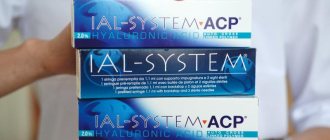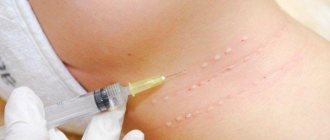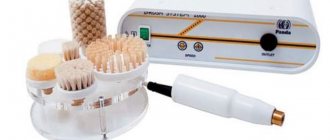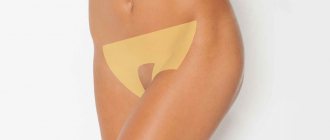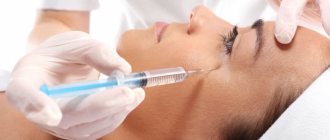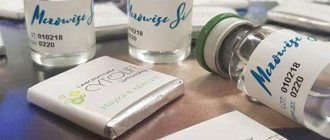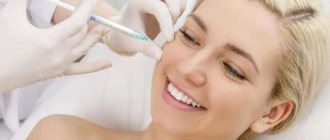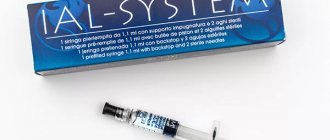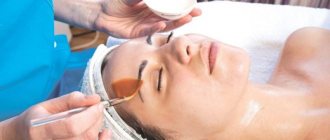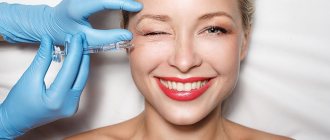Today, owners of beauty salons and clinics are forced to admit: the popularity of various “beauty injections” is no longer growing as quickly as before. Visitors understand that aesthetic medicine does not stand still, and in the 21st century you can look great without uncomfortable procedures, without pain, and the risk of unpredictable consequences can be practically reduced to nothing. A simple example is classical biorevitalization, a device for laser biorevitalization and fractional laser procedures.
Do you want to purchase the Fraxel re:store DUAL device? Call us 8 (800) 707-21-87!
Technology of the “Laser biorevitalization” procedure
Introducing hyaluronic acid into the skin is not an easy task, since its molecular weight is up to 5-20 million daltons. This size is about 20 thousand nm, which is hundreds of times larger than the intercellular spaces in the epidermis. This circumstance prevents the penetration of hyaluronic acid molecules into the deeper layers of the skin. In 2004, it was possible to develop a technology that meets all modern requirements and ensures adequate non-injection injection of hyaluronic acid into the deep layers of the skin: microgel and athermal infrared laser.
Microgel
It contains hyaluronic acid with ultra-low molecular weight. Molecules up to 40–60 kilodaltons penetrate most actively. They pass relatively easily to the papillary dermis, bypassing the epidermal barrier. Unmodified hyaluronic acid promotes active tissue hydration, but most importantly, it is actively integrated into the synthesis circuits (collagen, elastin, hyaluronic acid, etc.) in cells, being both a catalyst and a consumable material for these processes.
Athermal infrared laser
An athermal (low-intensity) laser is a source of laser radiation that, under the influence of current, converts electricity into light. The power of an athermal laser does not cause tissue heating and is therefore used in cosmetology. As a rule, these are red and infrared lasers, the impact of which increases the permeability of cell membranes, stimulates the activity of macrophages (cells that digest bacteria), and accelerates the proliferation of connective tissue cells (fibroblast proliferation). In addition, the effect of an athermal (low-intensity) laser expands capillaries and stimulates microcirculation (movement) of blood through capillary-type microvessels in the dermis, thus accelerating the elimination of metabolic end products.
Under the influence of such a laser, the shells of the nanospheres are destroyed and the hyaluronic acid molecules are restored to their original form in the base layers of the skin in the basal layer of the epidermis (in the deepest layer of the epidermis, located 1/10 of a millimeter from its surface, which is approximately equal to the thickness of three to four book pages ). As a result, the skin's natural production of new hyaluronic acid (a process similar to cell division) is stimulated, as well as the production of collagen and elastin fibers in a process called "selective fiber regeneration."
Athermal lasers do not heat or damage the skin and have a very gentle effect. Therefore, laser biorevitalization is extremely comfortable for the patient, does not cause peeling, redness and other unpleasant consequences, and does not require rehabilitation.
How is laser biorevitalization of the face performed?
There are two modes in which laser devices operate: pulsed and constant. The procedure has four stages:
- First, the skin is cleaned and gel is applied to it.
- The pulse mode is turned on, the active substance begins to flow deep into the epidermis.
- Then processing is carried out in a continuous mode. The areas of influence of the gel become wider, the effect lasts longer, the surface layers of the skin are moisturized from the inside.
- After the procedure is completed, the remaining drug is removed.
Hyaluronate used for revitalization belongs to the group of polymers. In any moving organism there is a molecular chain of many thousands, of which this substance is a natural analogue. The laser causes it to contract, so that it can freely penetrate even the deepest layers of the dermis. Once there, hyaluronate restores polymer chains, and they, in turn, restore the water supply that cells need. Water balance makes the skin more elastic, its healthy color returns, and wrinkles are smoothed out.
Immediately after the procedure, you can see that the face and neck have become more fresh, while there are no injection marks, redness, bruises or other signs of intervention. Therefore, you can conduct sessions whenever you want, and then you can easily return to normal life.
There are many benefits of the procedure. The effect of laser facial biorevitalization is as follows:
- the skin becomes soft and moisturized;
- after the sessions there is no irritation or dryness;
- turgor is restored;
- pores narrow;
- deep wrinkles become less noticeable, small ones are smoothed out;
- swelling and bags under the eyes disappear;
- the oval of the face looks clearer, the skin in the décolleté area is tightened;
- skin color becomes healthy;
- Overall, visible rejuvenation occurs.
The peculiarity of the procedure is that there is no need to specially prepare for it.
Before starting the session, the doctor cleanses the face. Then he begins to process the skin with the device.
How many facial laser biorevitalization procedures need to be done is determined individually. The patient's age and skin condition can be considered influencing factors. With noticeable aging, up to 10 procedures will be required at intervals of 4–7 days. After the first session, the effect can last up to 6 months.
Recommended articles on the topic:
- Ultrasonic facial peeling is a pleasant and beneficial procedure for your skin
- Redermalization of the skin: all the pros and cons
- Almond peeling for the face: features of the procedure
No special care is required in the subsequent period. But you need to drink more water (at least 30 ml per 1 kg of weight), use moisturizing creams.
In reviews of laser biorevitalization of the face, women note that the positive changes are obvious. In addition, the duration of the effect is observed.
There are practically no reviews about the negative consequences of laser biorevitalization of the face.
Advantages and disadvantages of laser biorevitalization
Advantages of laser biorevitalization:
- the distribution of hyaluronic acid in the skin is more even than with injections;
- under the influence of laser radiation, the activity of its own intradermal molecules of hyaluronic acid and their synthesis increases;
- laser phoresis of hyaluronic acid is accompanied by activation of the skin's regenerative resources and renewal of the skin;
- good tolerance;
- quick effect;
- no pain during the procedure;
- does not cause side effects or complications, does not require rehabilitation;
- has no seasonal restrictions;
- combines well with other techniques;
- the service is easy to offer to clients, as everyone knows about the beneficial properties of hyaluronic acid;
- The technique of the procedure is very simple.
Cons of the procedure
The main maximum effect of the procedure is associated with laser therapy and develops progressively over 1–2 months from the start of the course. However, the procedure does not affect muscle tone. This means that it is advisable to add additional methods of hardware cosmetology to the procedure, such as myostimulation and electroporation.
Application areas:
- full face,
- lips and area around the eyes,
- neck,
- neckline,
- hands.
What is laser hyaluroplasty?
This method is biorevitalization, that is, increasing the amount of hyaluronic acid. Each molecule of this unique natural polymer holds up to a million water molecules. Why is this so important?
Hyaluronic acid retains not just water, but intercellular fluid. It is through it that all cells, including fibroblasts and collagen fibers, are nourished. Collagen is a living protein and requires nutrition. With a lack of intercellular fluid, it begins to starve and collapse. This leads to loosening and destruction of collagen fibers.
Laser biorevitalization replenishes the lack of hyaluronic acid in the dermis, improves its hydration and nutrition of collagen fibers. In addition, hyaluronic acid activates the work of fibroblasts, which means the synthesis of new collagen. This ensures fast and lasting results of hyaluroplasty.
Zhmurina Natalya Borisovna
Director, Chief Physician of “A Clinic” Dermatovenerologist, cosmetologist
Indications and contraindications
Indications for laser biorevitalization:
- correction of wrinkles, especially crow's feet, wrinkles around the eyes;
- restoration of lip volume;
- effective moisturizing and nourishing of the skin;
- express lifting;
- preparing the skin for intense UV irradiation (resting in the south, visiting a solarium);
- restoration of skin after intense exposure to ultraviolet rays;
- preparing the skin for traumatic procedures (medium and deep chemical peels, microdermabrasion, plastic surgery);
- rehabilitation after skin damage during aggressive procedures (for example, deep peels);
- correction of scars (both as an independent method and as part of complex therapy).
Contraindications:
- individual intolerance to hyaluronic acid;
- malignant neoplasms, benign neoplasms with a tendency to grow;
- systemic blood diseases (blood clotting disorders);
- infectious diseases in the acute stage, active pulmonary tuberculosis;
- pregnancy at all stages;
- thyrotoxicosis;
- decompensated diabetes mellitus type 1;
- tendency to form keloid scars;
- tendency to hyperpigmentation.
What effect can you expect from laser biorevitalization?
- Visible skin rejuvenation (even after one session).
- Smoothing and reduction of superficial and medium wrinkles.
- High rejuvenation effect in the presence of a network of fine wrinkles.
- Restoration of skin density, appearance of shine and velvety.
- Reducing the number of wrinkles around the mouth and, as a result, increasing the volume of the lips.
- Restoration of skin after burns (solar and thermal).
Watch a video about laser biorevitalization
ON-LINE RECORD ORDER A CALL
Procedure
- Makeup remover It can be produced using any available means. Milk and toner are selected based on the client’s skin type.
- Then the skin is thoroughly cleansed and degreased using a special product. Ultrasonic peeling can be used as preparation.
- To facilitate penetration of the drug, it is necessary to steam the skin. To do this, a warm compress (40–45°C) is applied to one half of the face.
- Before starting laser treatment, it is necessary to protect the patient's eyes with opaque glasses.
- A low molecular weight hyaluronic acid preparation, preheated to 40–42°C (to improve fluidity), is applied to the surface of the skin. In addition, an increase in temperature leads to a decrease in molecular weight and thus facilitates the penetration of the drug into the dermis.
- Areas of skin with hyaluronic acid applied are treated with a laser. Under the influence of a laser beam of a certain wavelength, the free bonds of the hyaluronic acid molecule polymerize and form long chains. Only in the form of long chains does hyaluronic acid have biologically active properties. Processing can be carried out using either a stable or labile method. The presence of a special dermatological lens allows you to focus the laser beam - to work using the contact method, and in some laser biorevitalization devices - to treat areas of the face along massage lines. Processing time for one area is 1–1.5 minutes. Most devices emit a feedback signal, which helps control the processing time of one area. Working with one half of the client’s face according to the protocol takes 10 minutes. After the entire surface of the skin has been thoroughly treated, the procedure is repeated on the other side.
- After completing the laser treatment, you need to apply a warm compress again to further saturate the skin with moisture. Then the remaining gel is carefully removed using sponges.
- At the end of the procedure, special finishing products are applied to the skin, which also contain hyaluronic acid and other moisturizing components. These drugs allow you to enhance and prolong the effect of the procedure. Finishing products can also be recommended for home use during the entire course of procedures.
The laser biorevitalization procedure can be carried out once to achieve the “quick beauty” effect. The best result is achieved after a course of 5–7 procedures. Procedures should be carried out every other day. The course can be repeated after a year, depending on the condition of the skin, the client’s age and other characteristics.
Pros and cons of laser facial biorevitalization
The main advantages of laser biorevitalization:
- there are no punctures on the skin;
- spots and bruises do not appear;
- the procedure is painless.
Sessions can be held at any time of the year. Moreover, a couple of procedures before traveling south will help the skin become more resistant to ultraviolet rays and avoid photoaging. Upon returning from the sea, you can continue sessions that will restore tissue after active sun exposure.
But the procedure also has disadvantages:
- it should not be carried out if there are inflammations and purulent acne on the skin;
- cannot be done independently, as professional skills and special knowledge are required;
- It is prohibited to do sessions if there are oncological problems, during exacerbations of chronic skin diseases (eczema, psoriasis, lichen), or after operations.
We recommend
Laser aesthetic cosmetology: the perfect technique for an ideal appearance Read more
Although biorevitalization is generally non-traumatic, minor side effects may occasionally occur:
- mild soreness;
- swelling;
- hematomas;
- papules;
- redness.
Usually these phenomena do not pose a danger and almost all disappear after a couple of days on their own, except for bruises - they may linger a little longer.
Serious complications such as infection and allergies occur extremely rarely. In this case, medical intervention is required.
Which laser to buy for biorevitalization? Basic parameters of the devices
Wavelength of laser radiation.
The main wavelength used for biorevitalization is 780–830 nm. Some devices use additional red radiation sources: 635 nm and 655 nm. This allows you to work with high efficiency on all skin types.
Laser radiation is absorbed by the skin depending on its phototype (1-6 on the Fitzpatrick scale) and the actual melanin content of the skin. Since the presence in all beauty salons of a special device for measuring the optical properties of the skin and melanin content is unrealistic, they use waves of a longer range, which penetrate better, or use cluster sources (a nozzle or handpiece containing several sources of laser radiation simultaneously).
Laser radiation power.
The total power can range from 90 to 1800 mW for different models of devices. Power depends on the technical capabilities of the manufacturer. The larger the irradiated spot (cluster area), the greater the power required. Also, higher power allows the procedure to be more intense (the skin absorbs more laser energy in less time).
Light spot area.
The larger it is, the faster and more effective the procedure, as it allows you to more evenly treat the necessary areas of the skin.
The cost of hyaluronic acid, as well as its source.
Hyaluronic acid is of animal and biorecombinant origin. The latter is preferable, although somewhat more expensive. Hyaluronic acid of animal origin is produced from animal raw materials: cockscombs, ocular vitreous body of cattle, fish tissues. Recombinant hyaluronic acid is synthesized by specially bred microorganisms that are harmless to humans. These are more modern drugs that have a given molecular composition; their advantage lies in complete infectious safety and low allergenicity.
Mobilization is announced
Specialists who want to guarantee long-term results for their patients use a different approach to rejuvenation. The skin’s own capabilities for restoration and regeneration are very great, you just need to mobilize them correctly. It is necessary to stimulate the synthesis of autogenous collagen and hyaluronic acid instead of artificially introducing beneficial substances from the outside. This is exactly how fractional lasers ( Fraxel ) work. The finest laser beams form thousands of microscopic impact zones on every centimeter of the skin, where old collagen and hyaluronic acid, as well as other elements that lead to skin aging, are heated and destroyed. But viable cells located around each such microzone, on the contrary, are activated and very quickly restore the damaged area. Consequently, the structure of the skin is actually renewed in the area affected by Fraxel . How can one disagree with experts who figuratively describe the action of Fraxel like this: “The Fraxel laser creates thousands of mini-factories on every centimeter of skin for the production of its own collagen and its own hyaluronic acid.” It is important that the upper layers of the skin are not damaged. Fraxel is a modern method of natural rejuvenation with minimal risks. Isn’t this what almost every second visitor to a cosmetology salon wants?
You may also be interested in materials on the site:
- Ablative skin resurfacing using a CO2 laser: advantages of the method
- Pigmentation removal device
- Fraxel device: your skin is flawless
- Liposonix device is an excellent solution for your business
- Hardware methods of figure correction
- Thermage device: the path to youth in one procedure
